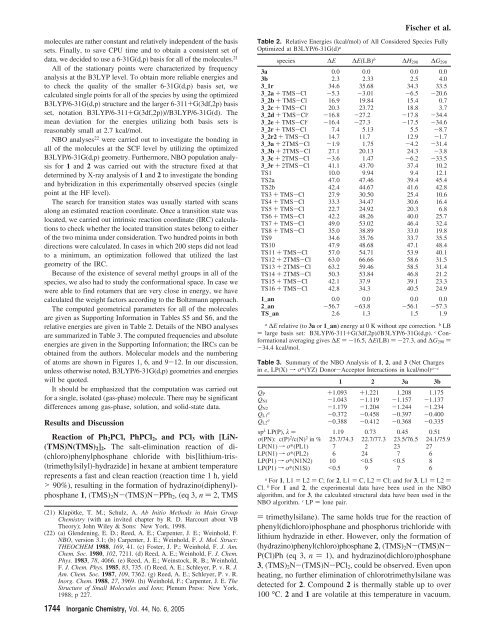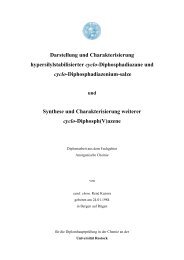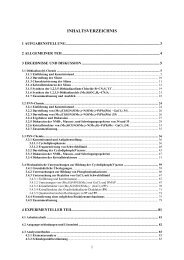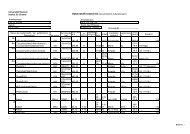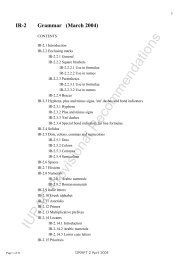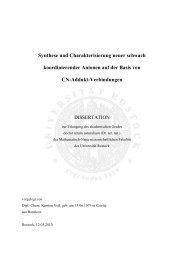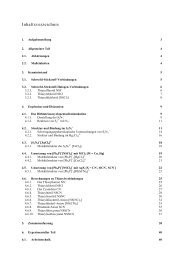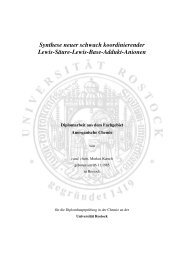Darstellung und Charakterisierung neuer niedrigkoordinierter ...
Darstellung und Charakterisierung neuer niedrigkoordinierter ...
Darstellung und Charakterisierung neuer niedrigkoordinierter ...
Create successful ePaper yourself
Turn your PDF publications into a flip-book with our unique Google optimized e-Paper software.
molecules are rather constant and relatively independent of the basis<br />
sets. Finally, to save CPU time and to obtain a consistent set of<br />
data, we decided to use a 6-31G(d,p) basis for all of the molecules. 21<br />
All of the stationary points were characterized by frequency<br />
analysis at the B3LYP level. To obtain more reliable energies and<br />
to check the quality of the smaller 6-31G(d,p) basis set, we<br />
calculated single points for all of the species by using the optimized<br />
B3LYP/6-31G(d,p) structure and the larger 6-311+G(3df,2p) basis<br />
set, notation B3LYP/6-311+G(3df,2p))//B3LYP/6-31G(d). The<br />
mean deviation for the energies utilizing both basis sets is<br />
reasonably small at 2.7 kcal/mol.<br />
NBO analyses 22 were carried out to investigate the bonding in<br />
all of the molecules at the SCF level by utilizing the optimized<br />
B3LYP/6-31G(d,p) geometry. Furthermore, NBO population analysis<br />
for 1 and 2 was carried out with the structure fixed at that<br />
determined by X-ray analysis of 1 and 2 to investigate the bonding<br />
and hybridization in this experimentally observed species (single<br />
point at the HF level).<br />
The search for transition states was usually started with scans<br />
along an estimated reaction coordinate. Once a transition state was<br />
located, we carried out intrinsic reaction coordinate (IRC) calculations<br />
to check whether the located transition states belong to either<br />
of the two minima <strong>und</strong>er consideration. Two h<strong>und</strong>red points in both<br />
directions were calculated. In cases in which 200 steps did not lead<br />
to a minimum, an optimization followed that utilized the last<br />
geometry of the IRC.<br />
Because of the existence of several methyl groups in all of the<br />
species, we also had to study the conformational space. In case we<br />
were able to find rotamers that are very close in energy, we have<br />
calculated the weight factors according to the Boltzmann approach.<br />
The computed geometrical parameters for all of the molecules<br />
are given as Supporting Information in Tables S5 and S6, and the<br />
relative energies are given in Table 2. Details of the NBO analyses<br />
are summarized in Table 3. The computed frequencies and absolute<br />
energies are given in the Supporting Information; the IRCs can be<br />
obtained from the authors. Molecular models and the numbering<br />
of atoms are shown in Figures 1, 6, and 9-12. In our discussion,<br />
unless otherwise noted, B3LYP/6-31G(d,p) geometries and energies<br />
will be quoted.<br />
It should be emphasized that the computation was carried out<br />
for a single, isolated (gas-phase) molecule. There may be significant<br />
differences among gas-phase, solution, and solid-state data.<br />
Results and Discussion<br />
Reaction of Ph2PCl, PhPCl2, and PCl3 with [LiN-<br />
(TMS)N(TMS)2]2. The salt-elimination reaction of di-<br />
(chloro)phenylphosphane chloride with bis[lithium-tris-<br />
(trimethylsilyl)-hydrazide] in hexane at ambient temperature<br />
represents a fast and clean reaction (reaction time 1 h, yield<br />
> 90%), resulting in the formation of hydrazino(diphenyl)phosphane<br />
1, (TMS)2N-(TMS)N-PPh2, (eq 3, n)2, TMS<br />
(21) Klapötke, T. M.; Schulz, A. Ab Initio Methods in Main Group<br />
Chemistry (with an invited chapter by R. D. Harcourt about VB<br />
Theory); John Wiley & Sons: New York, 1998.<br />
(22) (a) Glendening, E. D.; Reed, A. E.; Carpenter, J. E.; Weinhold, F.<br />
NBO, version 3.1; (b) Carpenter, J. E.; Weinhold, F. J. Mol. Struct:<br />
THEOCHEM 1988, 169, 41. (c) Foster, J. P.; Weinhold, F. J. Am.<br />
Chem. Soc. 1980, 102, 7211. (d) Reed, A. E.; Weinhold, F. J. Chem.<br />
Phys. 1983, 78, 4066. (e) Reed, A. E.; Weinstock, R. B.; Weinhold,<br />
F. J. Chem. Phys. 1985, 83, 735. (f) Reed, A. E.; Schleyer, P. v. R. J.<br />
Am. Chem. Soc. 1987, 109, 7362. (g) Reed, A. E.; Schleyer, P. v. R.<br />
Inorg. Chem. 1988, 27, 3969. (h) Weinhold, F.; Carpenter, J. E. The<br />
Structure of Small Molecules and Ions; Plenum Press: New York,<br />
1988; p 227.<br />
1744 Inorganic Chemistry, Vol. 44, No. 6, 2005<br />
Fischer et al.<br />
Table 2. Relative Energies (kcal/mol) of All Considered Species Fully<br />
Optimized at B3LYP/6-31G(d) a<br />
species ∆E ∆E(LB) b ∆H298 ∆G298<br />
3a 0.0 0.0 0.0 0.0<br />
3b 2.3 2.33 2.5 4.0<br />
3_1r 34.6 35.68 34.3 33.5<br />
3_2a+TMS-Cl -5.3 -3.01 -6.5 -20.6<br />
3_2b+TMS-Cl 16.9 19.84 15.4 0.7<br />
3_2c+TMS-Cl 20.3 23.72 18.8 3.7<br />
3_2d+TMS-Cl c -16.8 -27.2 -17.8 -34.4<br />
3_2e+TMS-Cl c -16.4 -27.3 -17.5 -34.6<br />
3_2r+TMS-Cl 7.4 5.13 5.5 -8.7<br />
3_2r2+TMS-Cl 14.7 11.7 12.9 -1.7<br />
3_3a+2TMS-Cl -1.9 1.75 -4.2 -31.4<br />
3_3b+2TMS-Cl 27.1 20.13 24.3 -3.8<br />
3_3c+2TMS-Cl -3.6 1.47 -6.2 -33.5<br />
3_3r+2TMS-Cl 41.1 43.70 37.4 10.2<br />
TS1 10.0 9.94 9.4 12.1<br />
TS2a 47.0 47.46 39.4 45.4<br />
TS2b 42.4 44.67 41.6 42.8<br />
TS3+TMS-Cl 27.9 30.50 25.4 10.6<br />
TS4+TMS-Cl 33.3 34.47 30.6 16.4<br />
TS5+TMS-Cl 22.7 24.92 20.3 6.8<br />
TS6+TMS-Cl 42.2 48.26 40.0 25.7<br />
TS7+TMS-Cl 49.0 53.02 46.4 32.4<br />
TS8+TMS-Cl 35.0 38.89 33.0 19.8<br />
TS9 34.6 35.76 33.7 35.5<br />
TS10 47.9 48.68 47.1 48.4<br />
TS11+TMS-Cl 57.0 54.71 53.9 40.1<br />
TS12 + 2TMS-Cl 63.0 66.66 58.6 31.5<br />
TS13 + 2TMS-Cl 63.2 59.46 58.5 31.4<br />
TS14+2TMS-Cl 50.3 53.84 46.8 21.2<br />
TS15+TMS-Cl 42.1 37.9 39.1 23.3<br />
TS16+TMS-Cl 42.8 34.3 40.5 24.9<br />
1_an 0.0 0.0 0.0 0.0<br />
2_an -56.7 -63.8 -56.1 -57.3<br />
TS_an 2.6 1.3 1.5 1.9<br />
a ∆E relative (to 3a or 1_an) energy at 0 K without zpe correction. b LB<br />
) large basis set: B3LYP/6-311+G(3df,2p)//B3LYP/6-31G(d,p). c Conformational<br />
averaging gives ∆E )-16.5, ∆E(LB) )-27.3, and ∆G298 )<br />
-34.4 kcal/mol.<br />
Table 3. Summary of the NBO Analysis of 1, 2, and 3 (Net Charges<br />
in e, LP(X)fσ*(YZ) Donor-Acceptor Interactions in kcal/mol) a-c<br />
1 2 3a 3b<br />
QP +1.093 +1.221 1.208 1.175<br />
QN1 -1.043 -1.119 -1.157 -1.137<br />
QN2 -1.179 -1.204 -1.244 -1.234<br />
QL1 a -0.372 -0.458 -0.397 -0.400<br />
QL2 a -0.388 -0.412 -0.368 -0.335<br />
sp λ LP(P), λ) 1.19 0.73 0.45 0.51<br />
σ(PN): c(P) 2 /c(N) 2 in % 25.7/74.3 22.7/77.3 23.5/76.5 24.1/75.9<br />
LP(N1)fσ*(PL1) 7 2 23 27<br />
LP(N1)fσ*(PL2) 6 24 7 6<br />
LP(P1)fσ*(N1N2) 10


